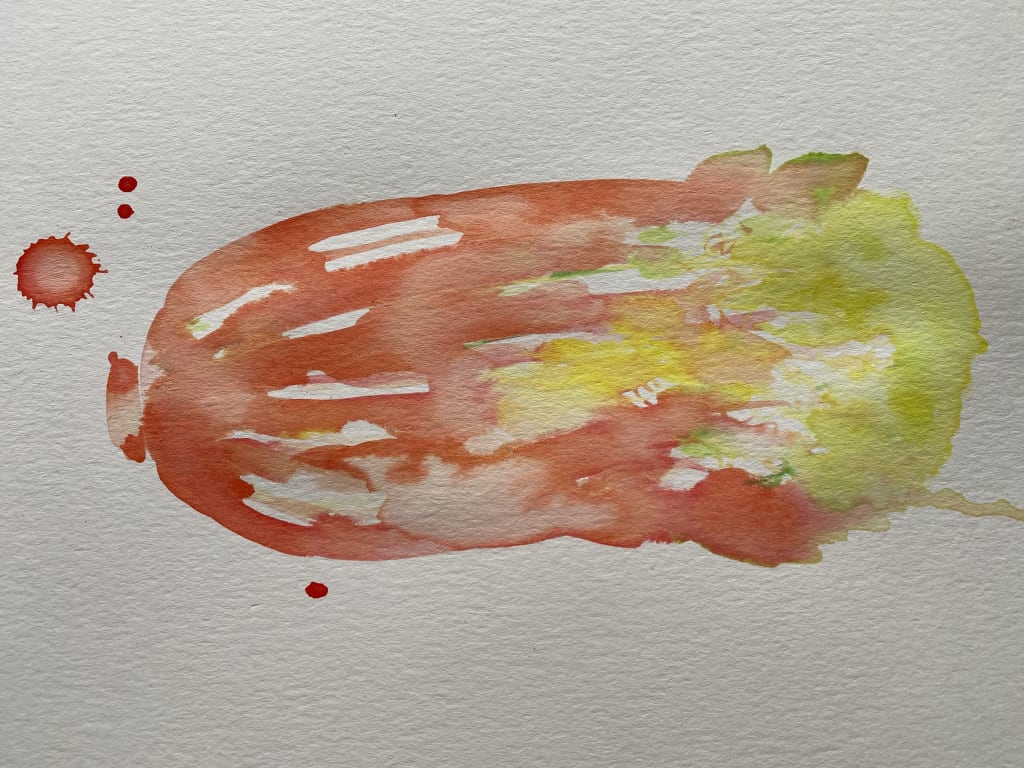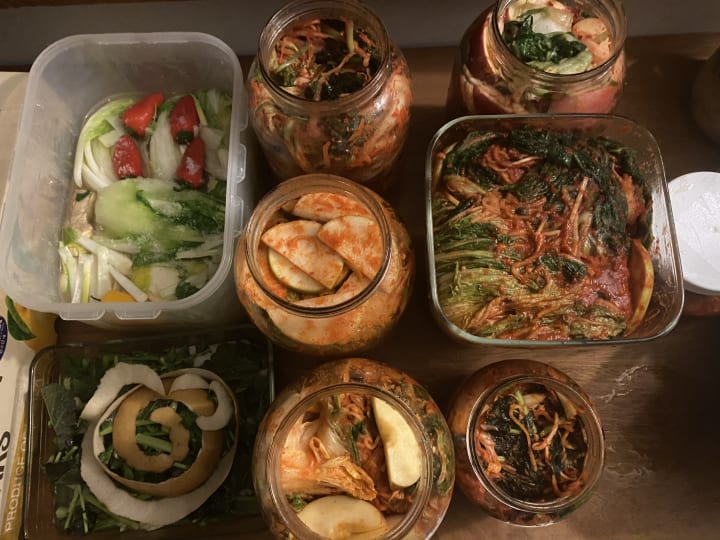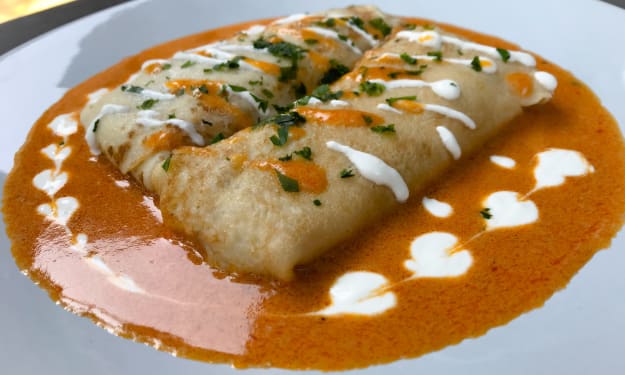Losing my Kimchi Virginity
Leaning into a family tradition marks my maturity.

They would gear up like this about twice a year - in the early part of autumns and springs. All manner of pails and tubs would be unearthed from the recesses of the house and brought together, including the standard 5-gallon bucket from the hardware store. My mother and grandmother are preparing for kimjang, a communal kimchi making session, continuing a tradition from the land from which we are born. There are a couple bushels of napa cabbage to preserve. My earliest memories are vague at best, but I can quickly conjure a feeling, the essence of a formless yet formative memory when the first waft of the kimchi filling hits my nose. For those who have been displaced, torn from their roots, food is the part of the culture we hang onto with the ferocity of a lioness protecting her cub. After all, we are what we eat.
I’m a little too little for being twelve and far from blossoming. I’m nimble and curious; moreover I know how to be helpful as does the rest of my family. We all pitch in; we have to – sometimes moving as one unit. Before we immigrated, women folk would gather when the harvest is bountiful, making light of the burden of heavy manual labor. Time for gossip, cracking jokes and walnuts, and delving into the nitty-gritty of family matters. Working in this way is no work at all, rather communion, ritual, and a way to tie each other to each other. I’m not yet aware of the significant ways that being raised in a different culture will create new pathways for me, but for now, I’m in the process of something that will keep me tethered to my family, my thousand-year-old culture, for the times I feel a little too little, in the vastness of the world. In this way, family matters.
I peek into a large tub, big enough to bathe my infant brother, set on the cemented floor of the area where we dine. It's an eat-in patio, a sturdy addition to the house patched in by my father and his brothers, the men practicing their communal labor. The mixture in the tub is a bright, bloody red goop. The smell is unmistakable, powerful, complex. Earth and clay, fire and brimstone, energy and alchemy interwoven into this mixture of vegetables, spices and salt, salt, salt. There’s also the presence of strange creatures of the sea - skanky fish sauce, a quart of oyster flesh, occasionally a whole fish. My mother rolls some of the mixture into a beautiful leaf of wilted cabbage and asks me to taste it. She asks me my opinion as if it matters and I get a sense of my own maturity on the horizon.

I’ve been working in New York City as a graphic designer for one of the world’s largest corporations. I decided to put my artistic acumen into commercial art and I landed a great job. So, I can’t understand why, but I’m unhappy, inexplicably anxious and I get sick often. My unhappiness starts to spiral and I’m now in a black hole of with so many questions of who I am. Every part of my life changes and so does my relationship with my work. Since everything is inside out, I take a break and recalibrate. I realize I have a natural and unceasing curiosity for food. I freaking love to eat and I’m constantly asking people to come over to sample my culinary tinkering. I became a chef. My intention is to learn how to cook food from every culture, superbly.
Within a decade, it happens again, I feel a manifest conclusion to a road I’ve taken. This hard, demanding, undervalued, manual labor of working in commercial kitchens isn’t sustainable. I try different aspects of the work and fare pretty well, but that feeling of dissatisfaction is still underfoot. Furthermore, my father is showing signs of dementia and it shakes me to my core. I’m in need of something that grounds me, keeps me from floating off with the centrifugal force of the earth in motion. I turn to the food I grew up with. After having been around the world’s cuisines, my soul cries out for familiar comfort. Strangely, after so many kimchi making sessions from my youth, I have no idea how to make Korea’s national dish, the ubiquitous icon of the culture.
I’m looking at recipes but I don’t quite trust them. From my memory bank, there was never anything written or calculated in finite terms. The cabbage is assaulted with handfuls of salt to draw out some of the water and wilt the crunchy leaves into something more malleable. Measured not in numbers but in feelings. Chili powder is poured into my mother’s beautiful, sturdy, cupped hands until there was...just enough. I stitch online recipes with my sensual memories of my twelve-year old self and lose my kimchi virginity. Maybe it’s because I’m working with these beautiful, giant cabbage flowers, but I feel like it's me who is blossoming. Kimchi teaches you that maturity requires time and honors your own unique timeline.

As I create, I learn and develop a full appreciation for the art of fermentation. I also freaking love the structure of napa cabbage. It has so many personalities depending on what part of the vegetable you are working with. There’s the gnarly, outer leaves, sometimes marked with tiny black spots, like freckles, weathered by the weather. The broad, outer leaves are a faded olive, appropriately military since they stand guard. The more tender leaves are packed underneath and they are white, green, bright, shiny, almost slick. Close to the heart, buttery, yellow fringed leaves are sweet and supple.
Weighing in at 3-4 pounds, there’s a lot of “meat” to a head of cabbage. Pruning shears make quick work of cleaning up this queen of vegetables, by trimming the hard core root end. It acts as the binding to the leaves of this member of the Brassica family. A sharp knife then splits the core and lower body lengthwise, I'm starting to quarter the cabbage. Because the leaves have vertical ribs, you can rip through the rest of the vegetable with bare hands like some mythical god/goddess. Once rinsed, the cabbage sits overnight with the salt acting as its transformative agent. The next day, it is rinsed and washed of excess salt and debris.
I ready myself for the next step of making the inside filling of baechu kimchi (whole-head napa cabbage.) I work quickly, intuitively, without thought but with thoughtful consideration. I have other tools, like a mortar and pestle, to crush, eek, coax as much flavor as I can from every ingredient in my arsenal. I’ve harvested chives from a small patch of earth I call a garden, snipping them just above the base with my trusty scissors, then trimming them into two-inch pieces. Harvesting chives this way, means the roots will regenerate another slender stalk. Miracles are always among us.
There’s garlic and ginger ground in medicinal quantities - ensuring health, vitality and immunity to those who partake. Proteins from the sea funk up the flavor like the beat dropping in your favorite part of your favorite song. Heaping spoonfuls of bright, red chili pepper coats everything into something sexy, saucy, and wickedly wild. The concoction is slathered in between the leaves of the cabbage, landing like adjectives on a blank page. I wrap up each quarter like a parcel, using reserved outer leaves, to put into a deep glass container.
Queen cabbage and I are in a dance. My past, present and future moments are all wrapped up in this humble act of making food. The process of fermentation means I’m working with living organisms, trusting them to do their job of creation and destruction. The beneficial bacteria, lactobacillus is proliferating and growing exponentially and adding an additional dimension that we experience as taste - sour, pungent, sometimes effervescent. Everything affects the fermentation process, the energy of the hands, the veggies themselves, the vessels that they sit in, and most importantly, the weather. And like anything that matures, it requires patience and time. Real slow for the deepest flavor.

A few weeks later, I have a clean canvas of steaming white rice. I’d been checking on the kimchi occasionally during its evolution; sometimes tracing the line of bubbles forming from the dynamic processes contained in the environment called the kimchi jar. My mother, who no longer has the strength to organize a kimjang, is still a happy and willing recipient to the tradition. My kitchen scissor, so handy in so many applications, is ready in hand for a sanguine bundle of fiber and flavor pulled from the jar. She carefully considers where she’ll make the first cut along the core and release all the leaves into more accessible pieces. Regardless, the first piece is a whole, broad leaf, much too big for one mouthful. So she uses her original cutting tool, her teeth, to rip through each crunchy, spicy, savory piece. With a small measure of grace, I run my forefinger along the side of the blade of the scissors, which is rich with the remnants of flavor.
About the Creator
Sung Uni Lee
My desires for the life I am creating:
Full expression.
Full engagement.
Fully in love.
in my Full Hearty way.
Writing to right my wrongs. Writing for levity. Writing to make sense of the less-sense.






Comments
There are no comments for this story
Be the first to respond and start the conversation.